Blogs
Knife
|
A knife (plural knives ; from Old Norse knifr ‘knife , dirk) is a tool or weapon with a cutting edge or blade , often attached to a handle or hilt . One of the earliest tools used by humanity, knives appeared at least 2.5 million years ago , as evidenced by the Oldowan tools . Originally made of wood, bone, and stone (such as flint and obsidian) , over the centuries , in step with improvements in both metallurgy and manufacturing , knife blades have been made from copper, bronze , iron , steel , ceramic , and titanium . Most modern knives have fixed blades or folding blades
Since prehistoric times , knives have been used as weapons , tools and tableware . However , it was only recently that knives were specifically designed for the dining table. In medieval Europe, the host did not provide tableware for the guests. Most people put their knives in the scabbards on their belts . These knives are very narrow , and the sharp points are used to pierce food and lift the food to the mouth to eat .
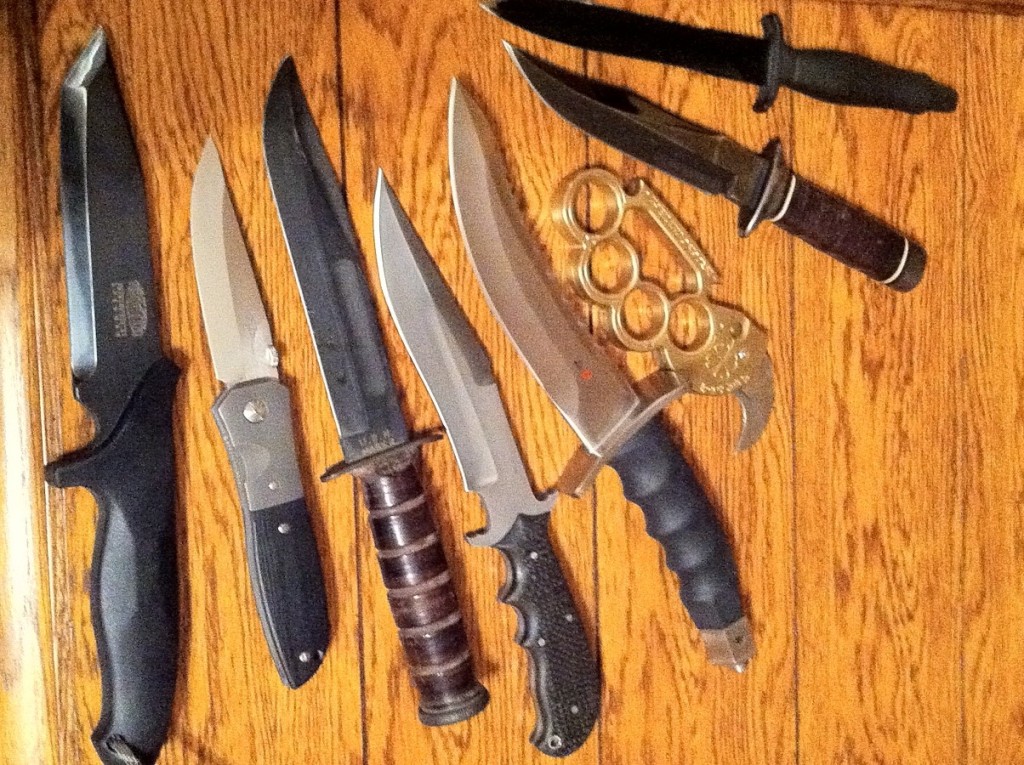
However , long after knives were used on the dining table , they were still used as weapons . Therefore , the multi-purpose nature of knives continues to pose a dangerous threat on the dining table . However , once forks begin to be accepted as a more effective way of taking food , the dangerous tip of a “table knife” is no longer needed .
Blade
The blade can be made of a variety of materials, each of which has advantages and disadvantages. Carbon steel, an alloy of iron and carbon, is very sharp. It can hold the edges well and is easy to sharpen, but it is easy to rust and stain. Stainless steel is an alloy of iron, chromium, and possibly nickel and molybdenum, with only a small amount of carbon. It is not as sharp as carbon steel, but has strong corrosion resistance. High-carbon stainless steel is a stainless steel with a higher carbon content, designed to combine the better properties of carbon steel and stainless steel. High-carbon stainless steel blades will not change color or stain, and maintain sharp edges. Laminated blades use multiple metals to create layered sandwiches, combining the properties of the two. For example, harder and more brittle steel can be sandwiched between softer and tougher stainless steel outer layers to reduce corrosion vulnerability. However, in this case, the part most affected by corrosion, the edge, is still very fragile. Damascus steel is a form of pattern welding similar to laminated structure. Layers of different steel grades are welded together, and then the inventory is manipulated to create patterns in the steel.
Titanium is a metal with a better strength-to-weight ratio, more wear-resistant, and more flexible than steel. Although the hardness is low and not sharp, the carbides in titanium alloys allow them to undergo heat treatment to achieve sufficient hardness. Ceramic blades are hard, fragile and lightweight: they can maintain sharp edges for years without maintenance, but are as fragile as glass and will break if dropped on a hard surface. They are not affected by ordinary corrosion and can only be sharpened on silicon carbide sandpaper and some grinding wheels. Plastic blades are not particularly sharp and are usually serrated. They are usually disposable.
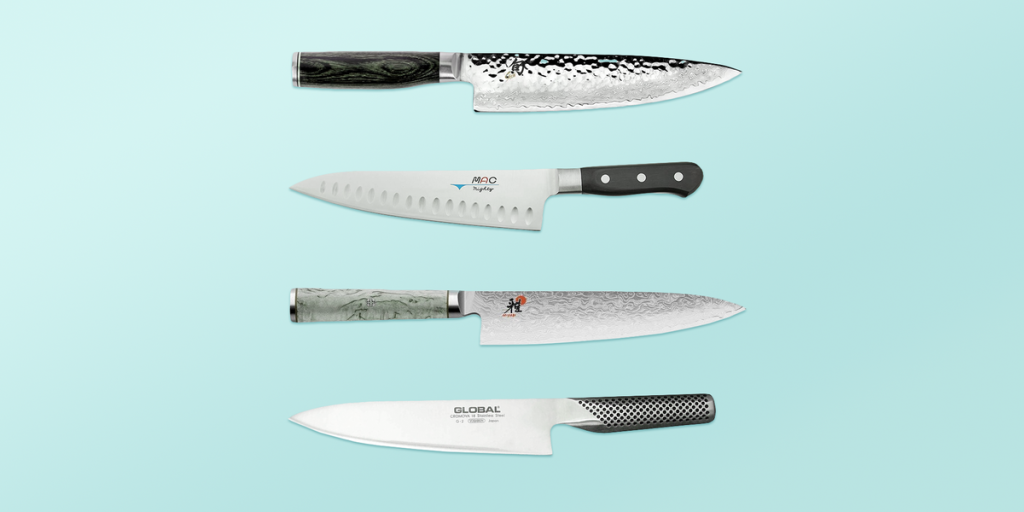
Steel blades are usually formed by forging or cutting. Forged blades are made by heating a single piece of steel, and then using a hammer or press to shape the metal while it is hot. The cutting blade is shaped by grinding and removing metal. With these two methods, after forming, the steel must be heat treated. This involves heating the steel above its critical point and then quenching the blade to harden it. After hardening, the blade is tempered to relieve stress and make the blade stronger. The mass-produced kitchen tableware uses forging and cutting processes. Forging is often reserved for manufacturers’ more expensive product lines, and can usually be distinguished from cut product lines by the presence of integral pads, although integral pads can be made by any kind of molding method.
Fixed blade
Fixed-blade knives, sometimes called sheath knives, do not fold or slide, and are generally stronger due to the tang, the blade extending into the handle, and the lack of moving parts.
Folding blade
The folding knife connects the blade to the handle through a pivot, so that the blade is folded into the handle. In order to prevent the blade from being accidentally closed on the user’s hand and causing injury to the user of the knife, the folding knife usually has a locking mechanism. Due to perceived strength (locking security), legitimacy, and ease of use, different locking mechanisms are favored by different individuals.
Handle
Knife handles can be made of many different materials, each of which has advantages and disadvantages. The handle has many shapes and styles. The handles are usually textured to enhance grip.
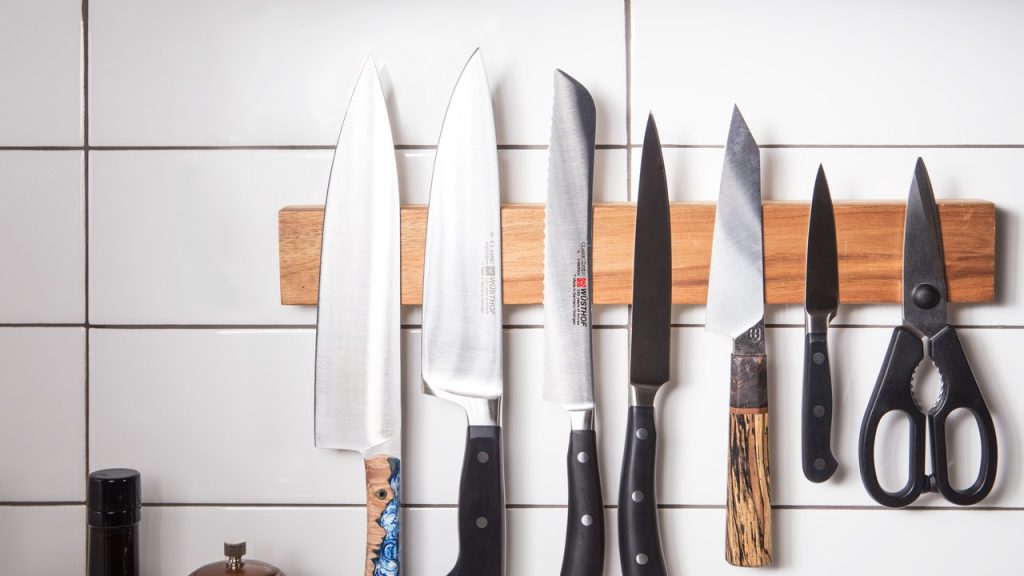
The wooden handle provides good grip and is warm in the hand, but is more difficult to care for. They are not very waterproof and will break or deform when exposed to water for a long time. Modern stabilized and laminated wood has overcome these problems to a large extent. Many beautiful and exotic hardwoods are used to make custom knives and some production knives. In some countries, for hygiene reasons, commercial butcher knives with wooden handles are now prohibited.
Plastic handles are easier to maintain than wooden handles, but they are slippery and become brittle over time.
The injection-molded handle made of high-grade plastic is composed of polyphthalamide, and when sold under brand names such as Zytel or Grivory, it is reinforced with Kevlar or glass fiber. These are usually used by major tool manufacturers.
Rubber handles such as Kraton or Resiprene-C are generally more popular than plastic handles because of their durability and cushioning properties.
Due to its toughness and stability, Micarta is a popular handle material for user knives. Micarta is almost impervious to water, has a strong grip when wet, and is an excellent insulator. Micarta refers to any fiber material cast with resin. There are many kinds of Micarta to choose from. A very popular version is the glass fiber impregnated resin called G-10.
Leather handles can be seen on some hunting and military knives, especially KA-BAR. Leather handles are usually produced by stacking leather washers or, less commonly, as a sleeve surrounding another handle material. Russian manufacturers often use birch bark in the same way.
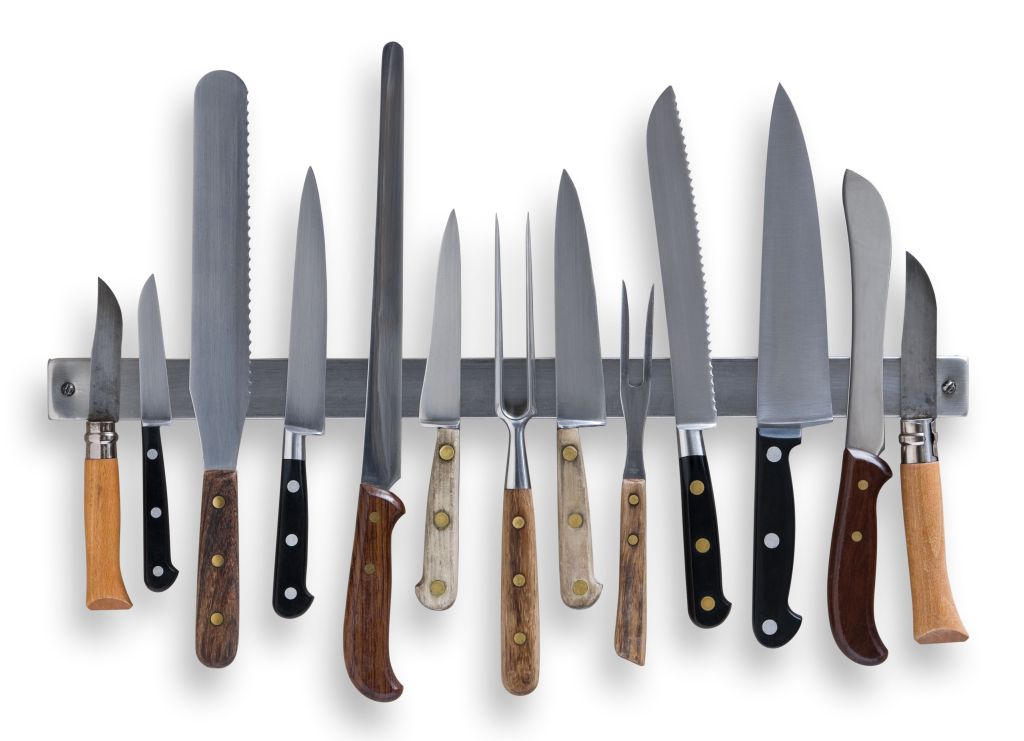
Skeleton handle refers to the practice of using the handle body as the handle, usually removing part of the material to reduce weight. The knives processed by the skeleton are usually wrapped with parachute rope or other wrapping materials to enhance the grip.
Stainless steel and aluminum handles are durable and hygienic, but they can be slippery. To solve this problem, advanced tool manufacturers have manufactured handles with ridges, bumps or indentations to provide additional grip. Another problem with knives with metal handles is that since metal is an excellent heat conductor, in a (very) cold climate, it may be very uncomfortable to operate these knives without wearing gloves or other protective gloves , Even painful or dangerous.
The handle can be adapted to the needs of the disabled. For example, for people with arthritis in their hands, the knife handle can be made thicker or more cushioned. The non-slip handle is suitable for patients with palm hyperhidrosis.
Utensils
One of the main aspects of the knife as a tool includes dining, used to prepare food or as tableware. Examples of this include:
Bread knife: a knife with a serrated blade used to cut bread
Deboning knife: A knife used to remove the bones of poultry, meat and fish.
Butcher knife: A knife mainly used for slaughtering and/or dressing animals.
Carving knife: a knife used to carve large pieces of cooked meat such as poultry, barbecue, ham and other large pieces of cooked meat.
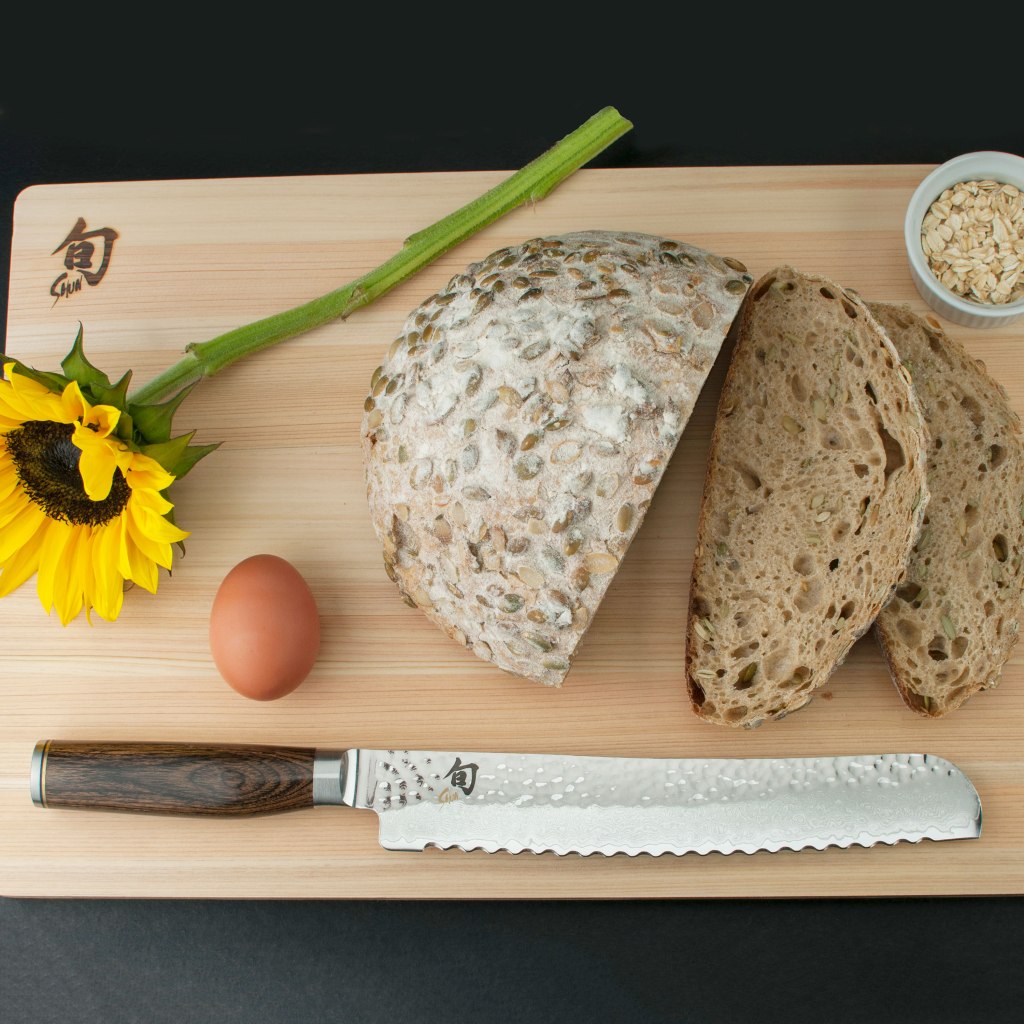
Chef’s Knife: Also known as French Knife, a cutting tool used to prepare food
Cleaver: A large knife, of various shapes, but usually resembles a long, square-edged axe. It is mainly used as a kitchen knife or butcher knife to cut into bones, and can also be used for crushing through its wide side (usually garlic).
Electric knife: an electrical device consisting of two serrated blades clamped together to provide sawing action when energized
Kitchen knife: Any knife used to prepare food, including chef’s knife
Oyster knife: has a short and thick blade, used to pry open the oyster shell
Mezzaluna: a two-handed arc knife used for rocking motion, used as a lawn cutter or cutting other food
Peeling knife or pitting knife: A knife with a small, sharp blade used to cut the pit from the fruit.
The rocker knife is a kind of knife that is cut by shaking, and is mainly used by people who cannot use a fork and a knife at the same time due to a disability.
Table knife or case knife: a piece of cutlery, which can be a butter knife, steak knife or both, is part of the table setting, accompanied by a fork and spoon
Finally, I would like to introduce a new tool brand :
YIERCITY will always provide the best value and most quality kichen supplies for all food lovers .
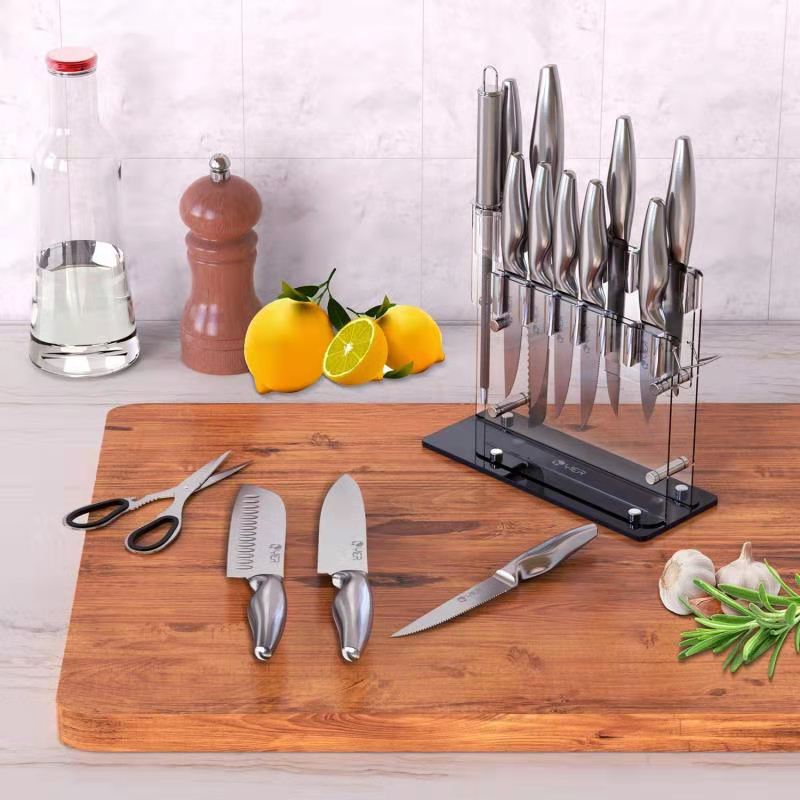
Why choose YIERCITY
We do professional knife set retail and wholesale business. We hope to be your stable global supporter and partner.
We are an enterprise integrating factory and trade, specializing in the design, manufacture and sales of high-quality knife sets.
We always make every effort to ensure the quality of each set of knives.
Why choose YIER Knives
● The complete knife set contains all kitchen knives.
● Delivery from the local warehouse, within 3 days.
● Manufactured in our own factory, cost-effective.
● Transparent acrylic knife holder, like a work of art
● Excellent materials, safe and durable.
● Free returns
● We listen to customer needs and feedback.